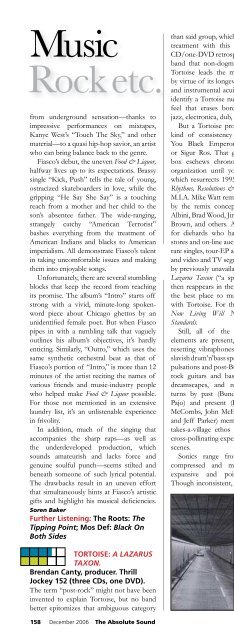You also want an ePaper? Increase the reach of your titles
YUMPU automatically turns print PDFs into web optimized ePapers that Google loves.
Music<br />
Rock etc.<br />
from underground sensation—thanks to<br />
impressive performances on mixtapes,<br />
Kanye West’s “Touch The Sky,” and other<br />
material—to a quasi hip-hop savior, an artist<br />
who can bring balance back to the genre.<br />
Fiasco’s debut, the uneven Food & Liquor,<br />
halfway lives up to its expectations. Brassy<br />
single “Kick, Push” tells the tale of young,<br />
ostracized skateboarders in love, while the<br />
gripping “He Say She Say” is a touching<br />
reach from a mother and her child to the<br />
son’s absentee father. The wide-ranging,<br />
strangely catchy “American Terrorist”<br />
bashes everything from the treatment of<br />
American Indians and blacks to American<br />
imperialism. All demonstrate Fiasco’s talent<br />
in taking uncomfortable issues and making<br />
them into enjoyable songs.<br />
Unfortunately, there are several stumbling<br />
blocks that keep the record from reaching<br />
its promise. The album’s “Intro” starts off<br />
strong with a vivid, minute-long spokenword<br />
piece about Chicago ghettos by an<br />
unidentified female poet. But when Fiasco<br />
pipes in with a rambling talk that vaguely<br />
outlines his album’s objectives, it’s hardly<br />
enticing. Similarly, “Outro,” which uses the<br />
same synthetic orchestral beat as that of<br />
Fiasco’s portion of “Intro,” is more than 12<br />
minutes of the artist reciting the names of<br />
various friends and music-industry people<br />
who helped make Food & Liquor possible.<br />
For those not mentioned in an extensive<br />
laundry list, it’s an unlistenable experience<br />
in frivolity.<br />
In addition, much of the singing that<br />
accompanies the sharp raps—as well as<br />
the underdeveloped production, which<br />
sounds amateurish and lacks force and<br />
genuine soulful punch—seems stilted and<br />
beneath someone of such lyrical potential.<br />
The drawbacks result in an uneven effort<br />
that simultaneously hints at Fiasco’s artistic<br />
gifts and highlight his musical deficiencies.<br />
Soren Baker<br />
Further Listening: The Roots: The<br />
Tipping Point; Mos Def: Black On<br />
Both Sides<br />
Tortoise: A Lazarus<br />
Taxon.<br />
Brendan Canty, producer. Thrill<br />
Jockey 152 (three CDs, one DVD).<br />
The term “post-rock” might not have been<br />
invented to explain Tortoise, but no band<br />
better epitomizes that ambiguous category<br />
158 December 2006 The Absolute Sound<br />
than said group, which gets the remix-heavy<br />
treatment with this budget-priced, three-<br />
CD/one-DVD retrospective. A post-grunge<br />
band that non-dogmatic jazzers can love,<br />
Tortoise leads the motley post-rock pack<br />
by virtue of its longevity, sundry references,<br />
and instrumental acuity. An aficionado can<br />
identify a Tortoise number by the left-field<br />
feel that erases borders between lounge,<br />
jazz, electronica, dub, and hip-hop.<br />
But a Tortoise project rarely boasts the<br />
kind of consistency found in Godspeed<br />
You Black Emperor!, the Dirty Three,<br />
or Sigur Ros. That goes triple here. This<br />
box eschews chronological and thematic<br />
organization until you get to disc three,<br />
which resurrects 1995’s out-of-print album<br />
Rhythms, Resolutions & Clusters (plus a long-<br />
M.I.A. Mike Watt remix), and is unified only<br />
by the remix concept, executed by Steve<br />
Albini, Brad Wood, Jim O’Rourke, Bundy K.<br />
Brown, and others. A five-star commodity<br />
for diehards who haven’t scoured record<br />
stores and on-line auctions for its bounty of<br />
rare singles, tour-EP and compilation tracks,<br />
and video and TV segments—all augmented<br />
by previously unavailable vault material—A<br />
Lazarus Taxon (“a species that disappears,<br />
then reappears in the fossil record”) is not<br />
the best place to make first acquaintance<br />
with Tortoise. For that, try 1996’s Millions<br />
Now Living Will Never Die or 2001’s<br />
Standards.<br />
Still, all of the collective’s signature<br />
elements are present, including the trendresetting<br />
vibraphones, fashionable but not<br />
slavish drum’n’bass spasms, savvy post-Reich<br />
pulsations and post-Buchla electronics, jazzrock<br />
guitars and basses, dizzying sound/<br />
dreamscapes, and nonchalantly virtuosic<br />
turns by past (Bundy K. Brown, David<br />
Pajo) and present (Dan Bitney, Douglas<br />
McCombs, John McEntire, John Herndon,<br />
and Jeff Parker) members as well as the ittakes-a-village<br />
ethos that unites Chicago’s<br />
cross-pollinating experimental rock and jazz<br />
scenes.<br />
Sonics range from claustrophobically<br />
compressed and murky, to generously<br />
expansive and pointillistically detailed.<br />
Though inconsistent, the mixes underscore<br />
the compatibility of the brainy deliberation<br />
and raw spontaneity that define Tortoise.<br />
Derk Richardson<br />
Further Listening: Gastr del Sol:<br />
Camoufluer; Jaga Jazzist: The Stix<br />
Buddy Guy: Can’t<br />
Quit the Blues. Jerry<br />
Rappaport, producer. Silvertone/<br />
Legacy 81967 (three CDs, one DVD).<br />
With a career that spans five decades,<br />
multiple record labels, and dozens of<br />
albums, Buddy Guy is tailor-made for<br />
and well-deserving of a box set. Despite<br />
limitless potential, Can’t Quit the Blues falls<br />
short of providing a definitive overview<br />
and showcasing Guy’s best work. Doing<br />
the opposite of what it should, the<br />
majority of the chronologically ordered<br />
triple-disc compilation is devoted to the<br />
guitarist’s late-period work and, ironically,<br />
serves as a condensed history of the<br />
blues’ decline into what’s mostly become<br />
an outmoded genre.<br />
The last surviving big-name<br />
representative of post-World War II<br />
blues, Guy began his run at Cobra before<br />
heading to the same Chess Studios at<br />
which many other fellow Chicago legends<br />
cut their famous sides. Guy arrived later in<br />
the game, but in time to be part of an era<br />
when electrified volts of gritty rhythms,<br />
cried vocals, and mussed-around backbeats<br />
poured out of urban apartment windows<br />
and dingy, street-level clubs. Guy’s torrid<br />
solos and scorching licks are present<br />
on cuts such as the iconic “First Time<br />
I Met the Blues” as well as subsequent<br />
Vanguard songs, i.e. 1968’s “One Room<br />
Country Shack.” Inexplicably, such<br />
material is colossally shortthrifted here,<br />
likely because of licensing issues. Guy’s<br />
depreciated work for JSP Records appears<br />
at the end of disc one, his sentimentally<br />
titled “DJ Play My Blues” indicative of<br />
the artist’s increasing desperation.<br />
The remaining bulk of the compilation<br />
spotlights selections from Guy’s comeback










